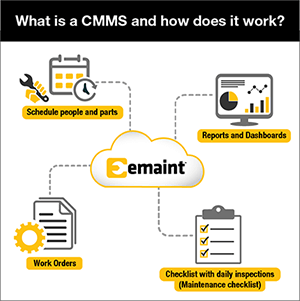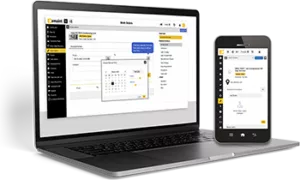By Michael Mills, Technical Solutions Manager at Fluke Reliability
Updated: July 16, 2025 • Originally Posted: 2021 • 10 min read
O que é um CMMS
A CMMS, or Computerized Maintenance Management System, is a maintenance software that helps teams manage work orders, analyze asset health, optimize inventory, report on KPIs, and more, centralizing your data and increasing efficiency.
Maintenance and reliability teams use CMMS software to plan, track, and report on their work, saving time and eliminating paperwork. The heart of a CMMS software is its database, centralizing and organizing all your maintenance and reliability data.
Here’s an example: 1) A motor breaks, and a passerby submits a work request via mobile. 2) A manager fires off a work order in response – booking a critical part and ordering more for next time. 3) A maintenance tech fixes the motor, snaps a photo, and closes out the work order. 4) Later that month, the manager pulls the reports on uptime – which, thanks to the CMMS, is at a record 99%.
A CMMS is key to your maintenance strategy in 2025, a time when global economic uncertainty and supply chain issues make defeating downtime more important than ever. We know that 66% of maintenance professionals now use a CMMS, up 24% from five years ago.
O que é um Sistema Informatizado de Gestão de Manutenção?
Here’s a basic breakdown of what a CMMS is, and what it does:
Haven’t Shopped for a CMMS In a While? Here’s What’s New in 2025.
A CMMS is a gamechanger for your maintenance team, helping you centralize your maintenance data so you can weaponize it for uptime wins and efficiency gains. We’ve seen a lot change in the industry since eMaint launched the first cloud-based CMMS in 2000, though, and even since I started in this industry over a decade ago. Today, a maintenance management system also needs to be mobile-friendly, global, and seamlessly integrated with key systems like ERPs, as well as supercharged by AI like Azima.
Here are a few key things I recommend when choosing the best CMMS software in 2025:
- Trust is everything: go with an industry leader like eMaint from Fluke with decades of expertise in global CMMS solution deployments and dedicated, in-house support. New start ups promise a lot, but don’t deliver.
- Connected reliability is a game changer: your CMMS needs to seamlessly integrate with your tech stack, from ERP to BI, SCADA systems, condition monitoring, and AI-powered predictive maintenance.
- Your provider should make your life easier: an easy-to-use interface, a powerful mobile app, multi-site and multilingual work, and especially adaptive configuration are table stakes.
Read on for the ultimate guide to CMMS software. What would you like to know next?
- Key Info: Key Features, Benefits, CMMS vs EAM
- Guide: What is the Best CMMS? A Guide to Choosing a CMMS in 2025
- Breakdown: CMMS FAQs
Try a CMMS for Free
Ready to try out a CMMS program for yourself? Take a look at the following interactive walkthrough experiences for a free clickable tour of a CMMS software.
Why Use CMMS Software? How a CMMS Helps Your Maintenance Team, and Your Business
A CMMS saves you time, boosts efficiency, cuts costs, and gives you the power to standardize wins in uptime globally – it’s a no brainer in 2025. You may wondering, though… do I really need a CMMS, or will excel spreadsheets and/or my corporate-mandated ERP do the trick?
Here’s what I kept hearing on the floor of our annual maintenance conference, Xcelerate 2025, this year. A CMMS that is built by maintenance experts, for maintenance teams, delivers far more value. Custom preventive maintenance checklists? Check. Audit trail optimized for 21 CFR Part 11 compliance? Built-in. Mobile app that empowers offline work? You’ve got it. Not to mention the seamless integration of maintenance data with condition monitoring, SCADA, and ERPs.
We see CMMS software in action every day – achieving results like 95% uptime or $1 million in cost savings – and it’s clear that you can only go so far without a CMMS/EAM solution.
CMMS Diagram
How Does CMMS Software Work? Overview of CMMS Features
CMMS software works by collecting and organizing maintenance data into a single, centralized database for your teams. You give your CMMS work order, equipment, and parts inventory data, and the software serves as a maintenance and asset management hub.
CMMS Features
Gestão de Ordens de Trabalho
What it is: A CMMS system is the best work order management software. You can create, assign, and complete work orders and work requests. Later, you can report on work order completion. Advanced features include automating work orders based on condition monitoring data – asset fails, work order fires.
Why it’s important: Getting work orders to your techs instantly can save millions in downtime costs. Paper work orders get lost. And analyzing maintenance costs is easy with a CMMS.
Gestão de ativos
What it is: Asset maintenance software like a CMMS solution gives you the power to track assets, organized in hierarchies, and view detailed maintenance history with a maintenance management system. You can also manage asset lifecycle, analyze costs, and keep track of uptime – powerful asset health insights.
Why it’s important: You don’t have to go searching for asset history details for work orders or audits for records. You can also measure asset performance and costs.
Manutenção Preventiva
What it is: Schedule recurring PMs, or preventive maintenance work orders, for assets that include tasks, procedures, and parts – your CMMS maintenance software should have an drag-and-drop calendar to make this easy. PM scheduling allows you to level-load schedules, avoid resource conflicts, and monitor on-time PM completion and compliance.
Why it’s important: Preventive maintenance is key to keeping things running smoothly, reducing your team’s work and your assets’ failures.
Gestão do inventário de peças
What it is: Book spare parts for work orders and attach them to relevant assets – a CMMS system is your global parts inventory management software. Monitor inventory levels and receive alerts when parts need to be reordered. Standardize and share inventory across sites to reduce costs and Mean Time to Repair (MTTR). Gain instant visibility into part usage trends and reorder thresholds through interactive dashboards.
Why it’s important: Managing thousands of parts can cause headaches. A CMMS makes it easy, and helps you keep costs down.
Relatórios, análises e painéis de controlo
What it is: Design report and dashboards of maintenance activities and build dashboards to gain visibility into key processes and KPIs like MTBF, MTTF, and MTTR. Use pre-built templates or custom workflows to track maintenance KPIs like OEE, PM completion rate, or uptime. Drill down into the data to uncover hidden costs and optimization opportunities.
Why it’s important: You can quickly see how your maintenance team is doing, and easily share that with leadership.
Conformidade regulamentar e painéis de auditoria
What it is: Easily build audit dashboards to demonstrate compliance to regulations like 21 CFR Part 11, SQF, BRC, and ISO. Review and report on records stored in a comprehensive audit trail. Safeguard key actions with electronic signatures. Track PM adherence, flag overdue tasks, and generate regulatory reports in a few clicks. Customize workflows to require approvals from quality, safety, or sanitation teams.
Why it’s important: Audits can take days to prepare for – with a CMMS, that can be hours or even minutes.
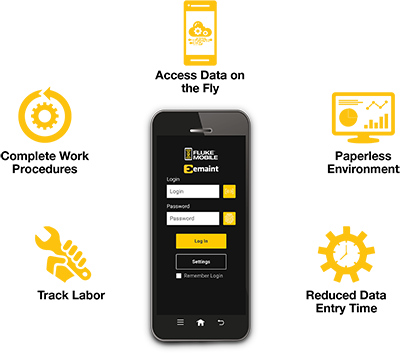
Aplicação CMMS móvel
What it is: Manage maintenance from the palm of your hand, from work orders to booking parts. Premium CMMS apps allow offline work that syncs later. Scan QR codes to access asset histories and submit work requests in seconds. Upload photos or videos from the field to enhance communication and documentation.
Why it’s important: Mobile work is much faster, and guarantees work orders are completed accurately.
Integrações
What it is: Integrate your CMMS system with your core business software, from SAP to Power BI, with API connections or through low-code integration. Tap into SCADA and PLC systems to access condition data. Eliminate data silos and automate time-wasting tasks by syncing maintenance data with ERP or procurement platforms. Use integration recipes to connect to key business systems with minimal IT overhead.
Why it’s important: Maintenance and key departments like finance are siloed with integrations – causing huge inefficiencies. Connecting the data changes everything.
IA e manutenção preditiva
What it is: A CMMS maintenance software like eMaint unlocks the power of predictive maintenance by integrating with vibration sensors and integrating AI-driven maintenance recommendations.
Why it’s important: We’re living in the age of AI-powered maintenance, where companies are seeing successes like saving $8.1 million in downtime costs with industrial AI. Our recent Fluke Reliability research revealed that 97% of maintenance professionals consider AI a viable solution to the manufacturing skills shortage.
How a CMMS Works: The Technical Answer
To get technical (which I regard as my right as a Technical Solutions Manager), a CMMS database is founded on a Relational Database Management System (RDBMS) like SQL. Data is organized into normalized tables. It’s composed of workflows, asset hierarchies, schema templates, preventive maintenance logic, and more that comes together into seamless system.
You can also break down a CMMS solution into four basic parts: 1. An operator interface by which you navigate the data; 2. A database, typically cloud-based these days; 3. Administrative settings and workflows that govern how the CMMS works; 4. Reporting dashboards.
To geek out even further – which we love to do here at Fluke Reliability and eMaint – we would recommend reading up on CMMS technology.
EAM vs. CMMS: What’s the Difference?
You may be wondering, what’s the difference between an EAM and CMMS system? They were originally quite different tools. Today, leading CMMS software can serve as an EAM system, but there are some key differences when generally speaking about the two – this article from the Journal of Industrial Information Integration has a great simple explanation:
What is EAM (Enterprise Asset Management) Software: “EAM aims to manage the asset’s lifecycle by enhancing its efficiency and reliability, reducing maintenance costs and risks.”
What is CMMS (Computerized Maintenance Management System) Software: “CMMS aims to assist in the planning, management, and administrative function required for effective and efficient maintenance.”
To put it simply, CMMS software was born out of a need for maintenance management – work orders, assets, parts inventory, reports. EAM software is focused on the bigger picture of asset lifecycle management: acquisition, asset health, lifespan, end of life (EoL), disposal.
There’s a few things to keep in mind for 2025, though.
- Today’s maintenance software can be both CMMS and EAM platforms. Just look at eMaint. Having worked in the maintenance software industry for over a decade, I can tell you eMaint is a powerful EAM solution.
- EAM software companies are facing a support crisis: they can’t get support right. Not everyone has dedicated, in-house support like eMaint does. We hear it again and again from customers: they’re being ignored.
- Get specific about what you need. Each provider is going to be different when it comes to functionality, no matter how they market themselves.
Benefits of CMMS Software
Now we come to the exciting part: the benefits of CMMS software for maintenance organizations. We’ll dive in, but before we do, if you’d rather read some real-life success stories, take a look. And then please return – we’re just getting to the good part!
CMMS Benefits: 5 Real-Life Case Studies
- Uptime: Advanced Atomization Achieves 95% Uptime
- PM Completion: Asahi Kasei Hits 97% On-Time PM Completion
- Standardization: SKF Standardizes Across 81 Facilities, 76,000+ Assets
- Reduced Costs: Crown Reduces Parts Inventory by $1.02 Million
- Predictive Maintenance: Jack Daniel Cooperage Moves into Predictive Maintenance
Quais são as vantagens do software CMMS?
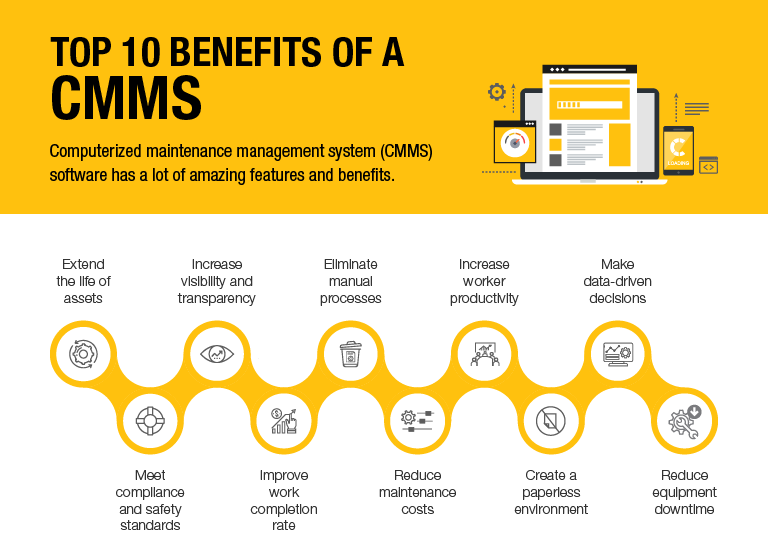
Boost Uptime
You can react to machine failures in real-time with a CMMS solution in the short term. And in the long-term, careful maintenance planning leads to sustained uptime and reliability.

Reduzir os custos
How much is your team wasting in maintenance, inventory, and labor costs? CMMS reporting can tell you – saving your team millions. Especially when you’re managing maintenance across many facilities.
Maximize Efficiency
Your CMMS system makes everything more efficient: you can see new work orders in real time, quickly find assets or parts, and schedule preventive maintenance so your team is free to do the work that really matters.
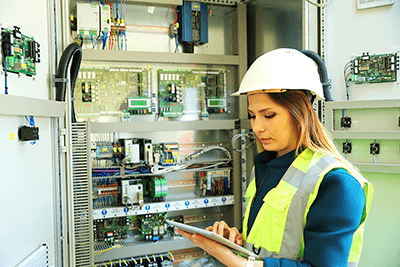
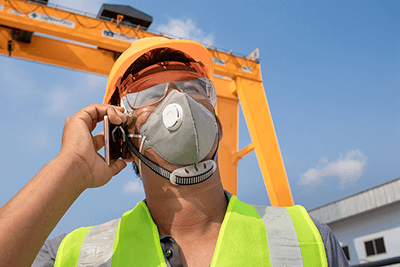
Mobile Workforce Management
Going mobile is the beauty of the modern CMMS: your techs can work in the field and offline, maximizing data entry quality. After all, mobile apps save techs an average of 44 minutes per day.
Healthy, Safety, Compliance
Your CMMS simplifies regulatory compliance: audit trails, SOPs, compliant workflows, and set-and-forget dashboards. Proper maintenance also ensures health, safety, and quality – not to mention sustainability and energy savings.
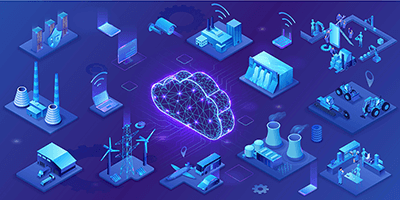
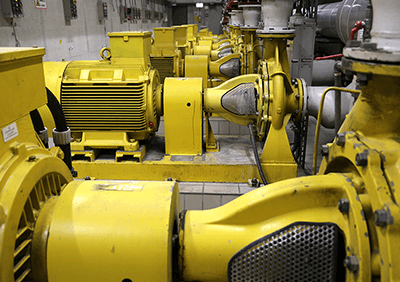
Automação
Automation saves time, reduces human error, and increases efficiency. With a CMMS solution, you can automate everything from inventory reorders to work order assignments and compliance reports.
Improve Asset Visibility & Reliability
A CMMS system allows teams to track and manage asset health and lifecycle from pre-installation planning and engineering to decommissioning. What is CMMS software if not a tool for increased visibility?

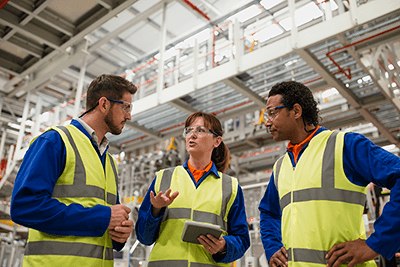
Standardization and Consolidation
Maintenance standardization – from best practices to data formats – is incredibly challenging. A CMMS can help you consolidate maintenance management across your global workforce.
Centralize Data
Your CMMS software is your source of truth for maintenance, giving you the power to report on KPIs like work order completion, mean time between failures (MTBF), multi-site inventory levels, and much more.
What is the Best CMMS Software in 2025? Your Guide to Choosing a CMMS
Now that you know what CMMS software is, it’s time to choose the best CMMS for you.
But there’s a problem: every CMMS says they can do everything. It’s frustrating, isn’t it? You may struggle to fill out a complex CMMS comparison checklist and then find out later your provider broke their promises. (Secret: reach out and we can help you fill out your comparison spreadsheet).
Today, CMMS capabilities are rapidly evolving, too – a lot has changed since we launched the first cloud-based CMMS in 1999. It’s hard to keep up.
What to Look For in a CMMS in 2025: The 5 Gamechangers
We’re currently in a renaissance for maintenance management system software – and what matters for choosing a CMMS has changed so much since eMaint began in 1986. Here’s my take on the five gamechangers that make a difference.
- Connected reliability: You’re not getting the maximum ROI from your CMMS if you can’t connect your tools and software in a maintenance ecosystem. A CMMS like eMaint gives you the power to bring in data from Fluke tools, vibration sensors, AI recommendations, ERPs, SCADA, Bis, and beyond. You should be able to see everything together for the full picture. Case Study: Asahi Kasei – 97% PM Completion, Power BI Integration
- Configurability: Here at eMaint, you dream it, and we build it. Your CMMS solution team should be experienced in industry-specific configurations, from PM procedures to 21 CFR Part 11 workflows.
- Mobile: The best CMMS software has a strong mobile app that is easy to use and empowers offline work in the field. Maintenance should be drive by real-time, actionable insights, always at your team’s fingertips.
- Global standardization: Your CMMS provider should have decades of experience in managing global, multi-site CMMS implementation that deliver results in uptime, OEE, and production efficiency. Take it from me – standardizing siloed teams, data, and processes is no joke. You need the best. Case Study: SKF – Standardization Across 81 Sites
- Trusted technology partner with decades of experience: Go with a true lifelong partner like Fluke who can guide you through the future of maintenance. We’re seeing a lot of brand-new startups pop up in this space who don’t know how to manage enterprise projects that span years. We also see people turn to legacy ERP platforms with terrible customer support. I’m really proud to be working with Fluke. We live and breathe maintenance.
Remember too that the best CMMS solution for you, is the one that best fits your organization’s particular needs – whether that’s optimizing 21 CFR Part 11 compliance, multi-site parts sharing, or something else specific to your operations. Have detailed conversations about those unique capabilities that matter the most.
P.S. multi-site standardization and consolidation best practicesI recently hosted a webinar on .
Types of CMMS Providers
A quick note: not all CMMS maintenance software and EAM providers are created equal. Maintenance leaders reach out to us daily with complaints of broken promises – after all, we know that only about 25 – 40% of CMMS implementations are successful.
- Newcomers and Start-Ups: A wave of new CMMS and EAM solutions have emerged over the last decade, promising much but lacking expertise in maintenance, CMMS technology, and global implementation.
- ERP Providers: Teams are still using their ERP as a maintenance software – limiting their abilities in work order and asset management, and often resulting in inefficiencies.
- Legacy EAM Providers: Legacy EAMs give you the security of a big name, but fail when it comes to dedicated support and configurability.
- World-Class CMMS & EAM Systems: I’m biased, but it’s well understood that a provider like Fluke, with decades of experience in global CMMS implementation, is the way to go. We win in technology, support, and expertise – and we care about our customers.
How to Handle Common Objections to CMMS Maintenance Software
We won’t end up using the CMMS.
Answer: Ask your provider for their plans for training, adoption, and return on investment (ROI).
Our data won’t be safe. IT will say no.
Answer: Your CMMS program should be transparent about security, privacy, and compliance with standards like ISO 27001:2022 or GDPR. The golden standard is the Fluke trust center. It’s all there for your IT team to review.
We don’t need a CMMS, we have an ERP. And it won’t work with our other software
Answer: A CMMS platform like eMaint is designed for maintenance teams – ERP maintenance modules are often outdated and inefficient. Your team should also remember that the best maintenance software works brilliantly with your ERP, BI, BMS, and beyond.
The 3 Secrets to Seamless CMMS Implementation
- Getting leadership buy in. Case studies can help – here’s one about how Johns Hopkins achieved 92% uptime.
- Getting your organization ready. Your team should be moving away from run-to-failure and towards proactive maintenance. Great records of your team, assets, parts, and work orders don’t hurt either.
- Invest in training and do it early. Early adoption is the key to long-term ROI.
The Verdict: The Best CMMS Software
eMaint is the best CMMS and EAM software when it comes to functionality, implementation, support, and software Return on Investment (ROI) – read our reviews on G2 or Gartner to learn why.
“eMaint has been a great system to use. Very user friendly and the support teams are amazing!” – Lisa T., Field Service Engineer. ★★★★★
“Hands down, the best CMMS I have ever used or seen.” – Michael R., Maintenance Supervisor. ★★★★★
“Simply the best CMMS.” – Carlos M, Preventive Maintenance Coordinator. ★★★★★
You can explore eMaint success stories to see the Fluke software in action.
Getting Started with a CMMS
Ready to learn more about how you can save time, maximize uptime, and cut costs with a CMMS platform? Reach out below to speak to a CMMS specialist.
About the Author
Michael Mills is a Technical Solutions Manager at Fluke Reliability, leading a team of solutions engineers dedicated to innovation and excellence in applying maintenance, reliability, and operations (MRO) strategies to CMMS and EAM implementation. With over a decade of experience in Enterprise Asset Management (EAM), Reliability Centered Maintenance (RCM), Condition-Based Maintenance (CBM), Integrated Condition Monitoring (ICM), Mills is an authoritative thought leader in the realms of asset management, mobile CMMS deployment, and IIoT monitoring.
CMMS Perguntas Mais Frequentes
Who Uses CMMS Software?
Maintenance teams of every size use computerized maintenance management software. Users can be anyone from entry-level technicians to maintenance managers, senior leadership, or corporate owners. The flexibility of a CMMS means it can be used across global, multi-site companies just as well as in smaller organizations with a single location.
O software do sistema de gestão de manutenção informatizado é utilizado numa grande variedade de indústrias:
-
- Fabrico de automóveis
- Ciências da vida
- Hotelaria (hotéis, estâncias, complexos de apartamentos, etc.)
- Petróleo e Gás
- Energia
- Química
- E muito mais
How Much Does A CMMS Cost? What if I Don’t Have Enough Money for a CMMS?
Your maintenance software will range in costs dependent on the number of facilities you are managing and your needs. eMaint is configurable enough to have a strong software package for every price range.
How Does a CMMS Support…
Preventive maintenance: scheduling out PM work orders and enabling PM checklists.
Asset history: providing a comprehensive asset hierarchy that shows maintenance history, including work orders, parts, and notes.
Parts inventory: simplifying parts inventory optimization with easy management, reordering, and cost reporting.
How Does CMMS Data Storage Work?
CMMS software is essentially a database that contains all information about an organization’s maintenance and assets. It works by collecting and organizing data about work order creation and assignment, tracking, reporting, asset status, and more. Then, it puts that information into a single centralized database that different departments can access and use to streamline their processes.
Cloud-Based vs. On-Premise CMMS
There are a range of maintenance management system solutions on the market, but they are generally divided into two types: on-premise or cloud-based CMMS. But which one is right for your operation? It depends.
On-premise CMMS solutions usually involve a higher upfront cost due to the expenses of purchasing and installing the necessary infrastructure to support the CMMS. They also require more in-house expertise.
Cloud-based CMMS solutions are subscription-based and tend to cost significantly less since you don’t have to purchase hardware to keep on-site or hire in-house IT professionals to handle installation, maintenance, and upgrades. They are also easier to scale. Most cloud-based CMMS platform providers issue free updates for existing users and include features to protect your data.
What is the Difference Between ERP and CMMS?
Enterprise Resource Planning (ERP) software is focused on purchasing, accounting, and the bigger picture of resource planning across and organization. A CMMS maintenance software is focused on managing maintenance and reliability activities, and can gather asset data to enable condition based maintenance.
Can SAP Be Used as a CMMS?
Systems, applications, and products (SAP) não é um sistema CMMS. É um tipo de pacote de software ERP. Embora exista alguma sobreposição entre o CMMS e o ERP, estes não têm o mesmo objetivo.
O CMMS foi concebido para racionalizar e otimizar as operações de manutenção. O ERP, por outro lado, gere uma gama muito mais alargada de funções empresariais, incluindo finanças, recursos humanos e relações com os clientes.
Integrating your CMMS with a SAP or other ERP can be very useful. eMaint is designed for smooth and intuitive ERP and SAP integration.
What is a CMMS Software Mobile App?
Um CMMS móvel é uma aplicação para smartphones que simplifica a gestão da manutenção em movimento.
As aplicações CMMS móveis ligam a sua equipa de manutenção, reduzem o trabalho e ajudam a maximizar o tempo de funcionamento dos seus activos. A comunicação é simplificada e a sua equipa pode trabalhar no terreno, simplificando a gestão da manutenção.
The eMaint CMMS app allows you to manage work orders, submit work requests via QR code, book spare parts, track work hours, and much more — all from a smartphone or tablet.
A premium mobile CMMS like eMaint gives you a wealth of features:
- Trabalhar fora de linha
- Ver e atualizar ordens de trabalho
- Carregar fotografias e documentos
- Registar as horas de trabalho
- Aceder a dados de multímetros Fluke e outras ferramentas
- Obter notificações push para alertas oportunos
- Gerir activos e equipamentos
- Digitalizar códigos QR nos activos para obter informações ou apresentar pedidos de trabalho
- Acompanhar as alterações com uma pista de auditoria
- Muito mais!
Um CMMS móvel, alimentado por um CMMS de classe mundial como o eMaint, derruba barreiras nos dados industriais e dá à sua equipa informação vital no terreno.
Que tipo de formação em CMMS existe?
Os principais fornecedores de software CMMS têm muitos tipos diferentes de formação CMMS disponíveis. Podem ter webinars gravados ou cursos que pode frequentar para aprender ao seu próprio ritmo, facilitando a escolha do que gostaria de aprender. Podem também oferecer formação no local, personalizada de acordo com as suas necessidades específicas, para que a sua equipa se actualize rapidamente e possa começar a beneficiar do seu novo CMMS ainda mais rapidamente. A formação contínua, como webinars ao vivo e workshops de formação de vários dias, pode ajudá-lo a aproveitar o poder das novas actualizações e ajudá-lo a tirar ainda mais partido do seu CMMS.
Posso obter a certificação CMMS?
Os principais fornecedores de software de sistema de gestão de manutenção computorizada também têm programas de certificação CMMS . Isto ajuda as equipas a aumentar a adoção e a utilização, mas também incentiva os trabalhadores. A certificação é a marca de um profissional de manutenção.

